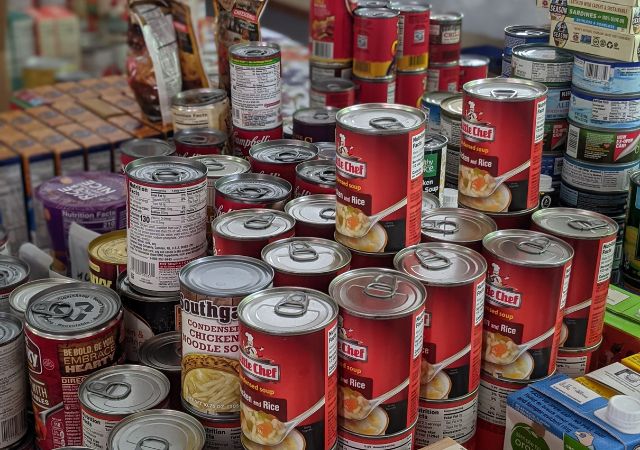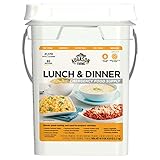Disasters can strike at any moment, leaving families without access to food, water, and shelter. Whether it’s a natural disaster or a man-made crisis, being prepared is crucial. One of the most important aspects of disaster preparation is food prepping. Having a stockpile of non-perishable food items can make all the difference in ensuring your family’s survival.
Food prepping is the process of storing food and supplies in advance of a disaster or emergency. It involves stocking up on non-perishable foods, water, and other essential items that can last for an extended period. While many people may think that food prepping is unnecessary, recent events have shown that disasters can occur without warning, leaving people without access to food and water for days or even weeks.
There are several reasons why food prepping for disasters is essential. First and foremost, it ensures that you and your family have access to food and water during an emergency. It also provides peace of mind, knowing that you are prepared for any situation that may arise. Additionally, food prepping can save you money in the long run, as buying in bulk and storing food can be more cost-effective than purchasing items individually.
Importance of Food Prepping for Disasters
Preparing for a disaster is crucial for ensuring the safety and well-being of you and your family. One of the most important aspects of disaster preparedness is food prepping. Here are a few reasons why:
Ensures Adequate Supply of Food
Disasters can strike at any time, and they often come with little to no warning. In the event of a disaster, grocery stores may be closed or out of stock, leaving you with limited options for food. By prepping food in advance, you can ensure that you have an adequate supply of food to sustain you and your family during an emergency.
Having a well-stocked pantry with non-perishable items such as canned goods, dried fruits, and nuts is essential. You should also consider storing items that require minimal preparation, such as instant noodles and energy bars. Additionally, it is important to have a supply of water for drinking and cooking.
Saves Time and Money
Prepping food in advance can also save you time and money in the long run. In the event of a disaster, you may not have access to electricity or gas to cook food. By prepping food in advance, you can avoid the need to purchase expensive and often unhealthy fast food or takeout.
Additionally, prepping food in bulk can save you money on groceries. By purchasing items in bulk and storing them properly, you can save money on your grocery bill and ensure that you have a supply of food that will last for several weeks or even months.
Provides Peace of Mind
Finally, prepping food for disasters can provide peace of mind. Knowing that you have a supply of food and water in the event of an emergency can help alleviate stress and anxiety. It can also help you feel more in control during a chaotic and uncertain time.
Overall, food prepping for disasters is an essential aspect of disaster preparedness. By ensuring an adequate supply of food, saving time and money, and providing peace of mind, you can be better prepared to handle any emergency that comes your way.
Types of Foods to Include in Disaster Food Prepping
To start disaster food prepping, you must consider what would happen if do not have access to fresh food. It is possible that supermarkets may be closed or you might not have electricity to power your fridge or microwave.
Non-Perishable Foods
When prepping for a disaster, it is important to include non-perishable foods in your emergency food supply. These are foods that can be stored for long periods of time without spoiling. Non-perishable foods include:
- Canned fruits, vegetables, and meats
- Dried fruits and nuts
- Canned or powdered milk
- Canned or dried beans and legumes
- Crackers and other dry, packaged snacks
- Cereals and granola bars
- Peanut butter and other nut butters
Make sure to check expiration dates on all non-perishable foods and rotate them out as needed to ensure freshness.
High-Energy Foods
In a disaster situation, you may need to expend more energy than usual. It is important to include high-energy foods in your emergency food supply to keep your energy levels up. High-energy foods include:
- Energy bars and gels
- Trail mix and other nut and seed mixes
- Beef or turkey jerky
- Dried fruits and vegetables
- Canned or vacuum-sealed fish or meat
- Instant coffee or tea
- High-energy foods are also great for outdoor activities like hiking and camping.
Comfort Foods
In a stressful situation, it can be helpful to have some comfort foods on hand to boost morale. Comfort foods include:
- Chocolate or other candy
- Cookies or other baked goods
- Instant soup or ramen noodles
- Canned or boxed macaroni and cheese
- Instant mashed potatoes
- Hot cocoa mix
While comfort foods should not make up the majority of your emergency food supply, they can provide a much-needed boost in morale during a difficult time.
How to Start Food Prepping for Disasters
One of the hardest things about food prepping for disasters, is knowing where to start. Use this tips as a guide for starting your food prep.
Assessing Your Needs
Before you start food prepping for disasters, assess your needs. Consider the number of people in your household, their dietary restrictions, and the length of time you want to prep for. Take into account the types of natural disasters that are common in your area and the potential for power outages or water shortages. Make a list of the foods that your family eats regularly and identify which ones have a long shelf life. This will help you determine what types of foods to include in your stockpile. Consider purchasing items that can be used in multiple recipes to maximize your options.
Planning Your Meals
Planning your meals is an important aspect of food prepping for disasters. Consider the types of meals that are easy to prepare without electricity or gas, such as canned soups or stews. Look for recipes that use shelf-stable ingredients like rice, beans, or canned vegetables. Consider purchasing a camping stove or other portable cooking equipment to use in case of a power outage. Make sure you have an adequate supply of fuel for your cooking equipment and a way to start a fire if needed.
Building Your Stockpile
Building your stockpile is the final step in food prepping for disasters. Start by purchasing non-perishable items with a long shelf life, such as canned goods, dried fruits, and nuts. Consider purchasing items in bulk to save money. Make sure to rotate your stockpile regularly to ensure that the items are still fresh and safe to eat. You also have to keep track of expiration dates and use older items first. Store your stockpile in a cool, dry place away from direct sunlight.
In addition to food, make sure to stockpile plenty of water. Store at least one gallon of water per person per day for at least three days. Consider purchasing a water filtration system or water purification tablets in case your water supply becomes contaminated. By assessing your needs, planning your meals, and building your stockpile, you can be better prepared for a disaster. Remember to regularly rotate your stockpile and stay up to date on any changes in your household’s needs.




